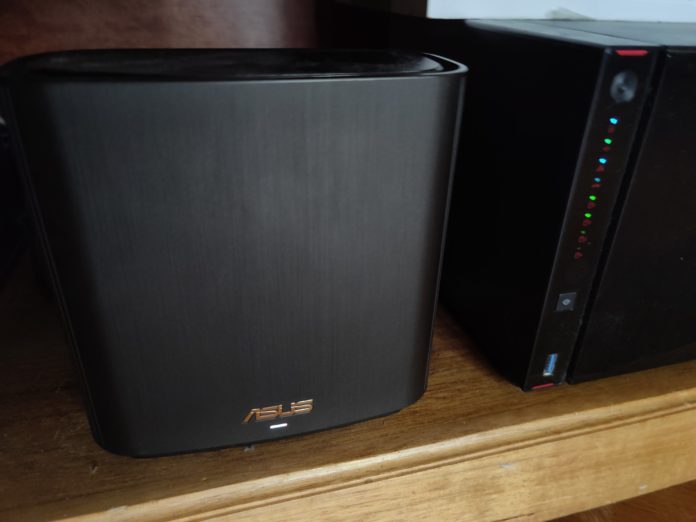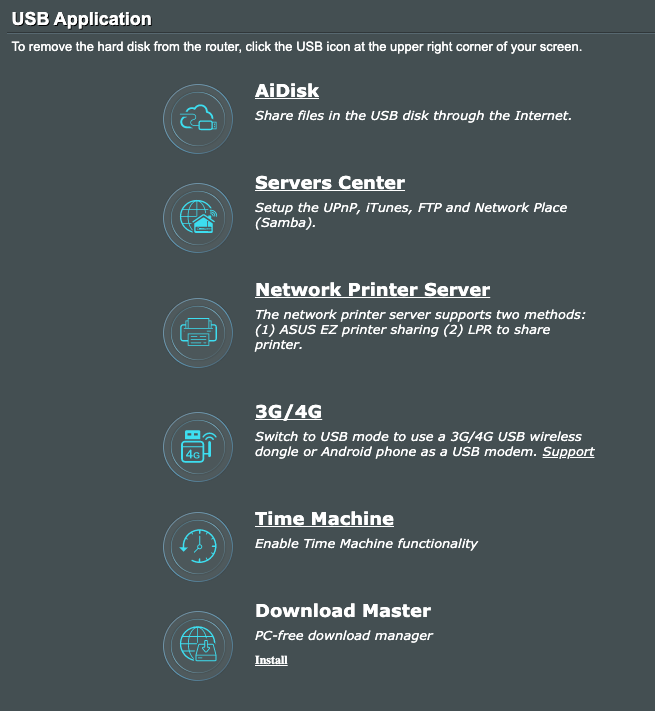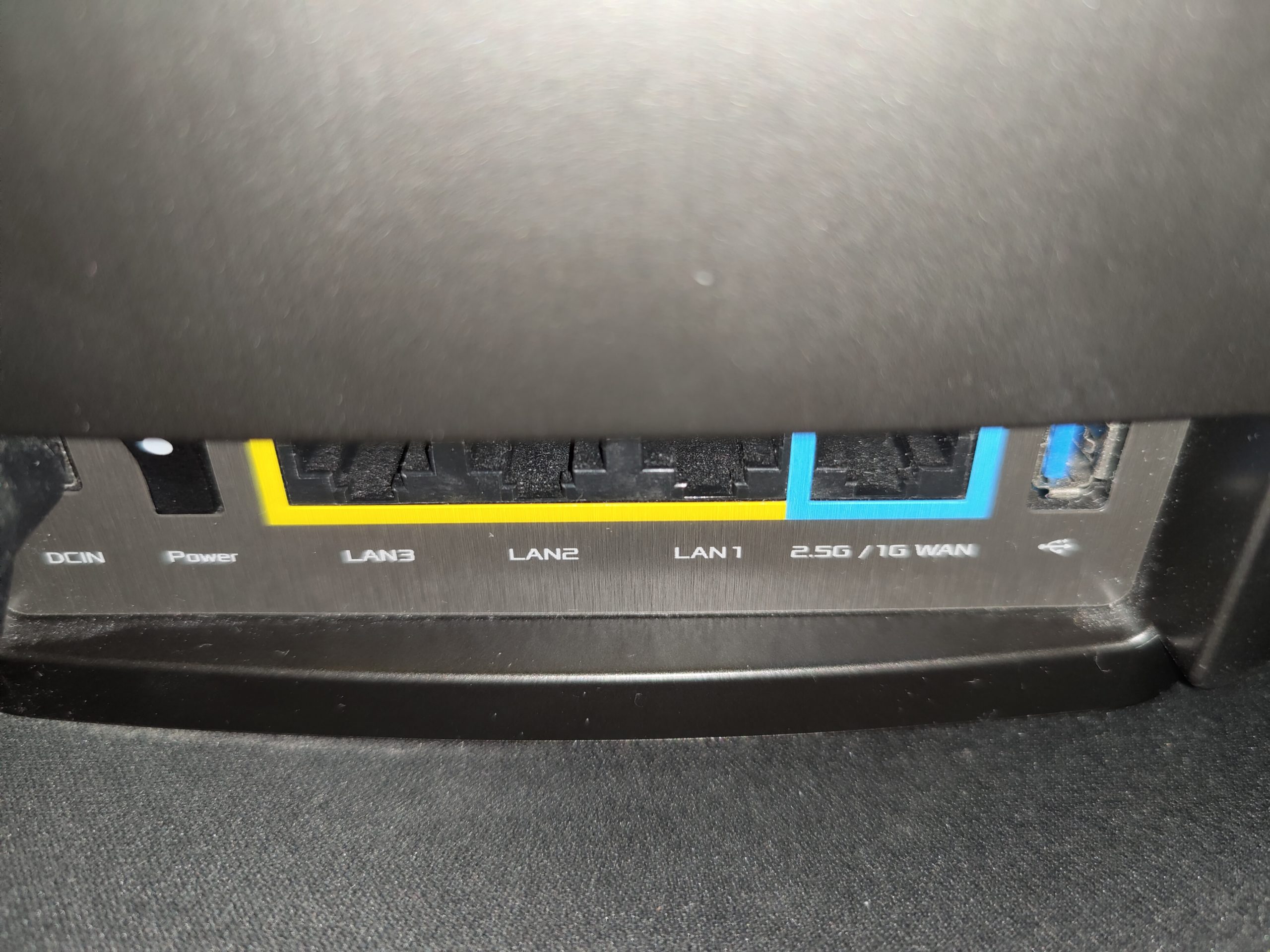You can still get a plain old broadband router, but if you’ve even got a hint of Wi-Fi coverage issues in your house you should consider mesh as an option. It’s not just because of the better coverage, it offers some other bonuses like higher data handling capacity. Wi-Fi 6 is a new and very big change to wireless connectivity, that as a stand-alone product has huge advantages too. So when you take a quality Mesh system and Wi-Fi 6 then jam them into a single product you get something a bit special, let’s take a look at the Asus Zen Wi-Fi XT8 which has the very best of both worlds.
Hardware, setup and monitoring
When you’re talking about a Mesh Wi-Fi setup, the starting point is a two-node (physical devices) kit. That is what we’re dealing with here on the XT8, two nodes that are rather pleasing on the eye, their power packs and a network cable. There isn’t much else you need to get this set up off the ground.
A closer look at the hardware
The nodes are — as already mentioned — really pleasing visually by their understated nature. On the rear of the devices, you’ll find a power plug, power rocker, four RJ45 ports (3 x LAN, 1 x WAN) and a USB Port. The LAN ports are important for a couple of reasons linking the base stations together if they’re too far for the wireless backhaul and, of course, connecting hardware to the nodes.
Being a WAN capable router, the XT8 will support connectivity for NBN connections or if you simply want to improve your wireless by implementing Wi-Fi 6 Mesh. They’re really subtle in presentation with their colour (black or white) and don’t stand out with a dozen LEDs blinking and drawing attention. I understand the reason for their physical size but compared to some other options we’ve seen recently they’re quite imposing in size.
Setup is quick and so very easy…
Like a lot of their competitors, the Asus app makes setting up the Zen Wi-Fi easy, so easy it’s actually disconcerting. That is, providing you have the details for your ISP to hand, but they’re generally not hard to get hold of. After that, you can simply follow the on-screen steps within the app to set up your connection and then the Mesh Wi-Fi link between nodes.
Mesh Wi-Fi delivers a single SSID (Wi-Fi “name”) from multiple wireless nodes which communicate with each other on a separate channel or hardwired connection. This results in less latency on your wireless connection, better speeds and seamless transition between nodes to maximise your coverage even in a large deployment network.
When you do place the nodes, it’s likely one will be in a position dictated by your NBN termination point. The second should be within a couple of rooms, ideally as high as possible to ensure that you’ve got the best transmission range for your Wi-Fi.
The Asus App and web interface
What I really liked about the app was that it’s simple but exceedingly powerful at the same time. From the first step through to connecting devices, it’s very capable of being your only interface with your network to set up, control and monitor everything. A user with essentially zero networking knowledge could easily connect this system in under half an hour. Then moving deeper into the setup, you can do some really complex setups if you need it as well.
Smart options: Alexa and IFTTT
Smart connections on routers are becoming more common as time goes by. Asus made the decision to go with Alexa and IFTTT for the XT8. There’s a lot of skills available through either of the options including:
- Enable (permanently or for a set period) or disable the main or guest Wi-Fi
- Reboot the router
- Upgrade the firmware
- Blocking and re-enabling internet access on devices
Both offer — on paper — excellent feature sets, but unfortunately I was only able to test IFTTT in a limited capacity due to their recent introduction of a subscription model and my lack of Alexa equipment in the house. There is undoubtedly plenty of room for growth in both and I’m genuinely looking forward to seeing where the voice integrations go in the future.
Other features
There’s a heap of other useful features that help you control your network and protect your family online. The one’s that really caught our attention while perusing the options were:
- AI Protection which offers active protection against malicious sites and parental controls.
- Traffic Analyzer giving you some visibility on who is using how much bandwidth and for what.
- USB Application allows you to use your USB port for multiple purposes including sharing a disk to the Internet, a network print server, plug in a 4G stick for back up connectivity or even a download manager
- VPN Server/Client allows you to create your own VPN to home or connect to another one in order to protect your privacy.
There’s so much functionality in this that it’s impossible to explore it all, at least without going into multiple thousands of words in the review.
What areas need improving?
In terms of technical delivery and without going to the level of business or enterprise-grade equipment, I haven’t seen a better list of features and data delivery capacity. Honestly, that makes it very difficult to fault the XT8 setup. It’s Wi-Fi 6 so (for now at least) somewhat futureproof for device connections and scalability of your network. It’s got a really broad set of advanced networking features and physically each node has 4 Ethernet ports. Perhaps some additional LED indicators for status would be good but I can’t really fault that since it was a clear decision and the light colour does give status.
The biggest issue I can pick that will prevent potential buyers from becoming buyers is the price. At $750.00 (on special at the time of publishing this review, normally $899.00) that really is a big hurdle for potential buyers to overcome. Unfortunately, based on personal experience in the IT field a lot of users won’t see the value or longevity of the far better product despite sales efforts.
Does the performance match the price?
That is a very big question, but frankly, the price is pretty big too. When you look at what the Zen Wi-Fi XT8 offers, it does pretty much everything you could imagine for home, small and even many medium-sized businesses.
Setting it up is very simple and only take a matter of minutes, with no real hitches in getting online quickly. Once devices were connected, the coverage was truly outstanding (primarily because I have figured out where to place Mesh nodes) through my home, across the property and even a surprising distance down the road. Added to the range of the Wi-Fi was the advantages that Wi-Fi 6 brings to the table with bandwidth sharing and data delivery.
The capability to link to Alexa or IFTTT really does add a bit of polish to the whole arrangement, allowing users to control a number of key functions on the router. The reality is that moving forward our homes are going to become more connected, needing the reach of Mesh which the XT8 delivers as a scalable option.
If you’ve got the big-budget and desire to check this system out a bit closer, the Asus Website has a comprehensive list of where to buy (online or in-store) the Zen Wi-Fi XT8 system.


















